Edible weeds are all around us, often unassuming, always resilient, and humble. These 12 edible and useful backyard weeds are easy to forage for. Most are wild plants you have likely seen your whole life without realizing how amazing they are. Learn all about these wild-growing, strong, edible, and useful weeds!
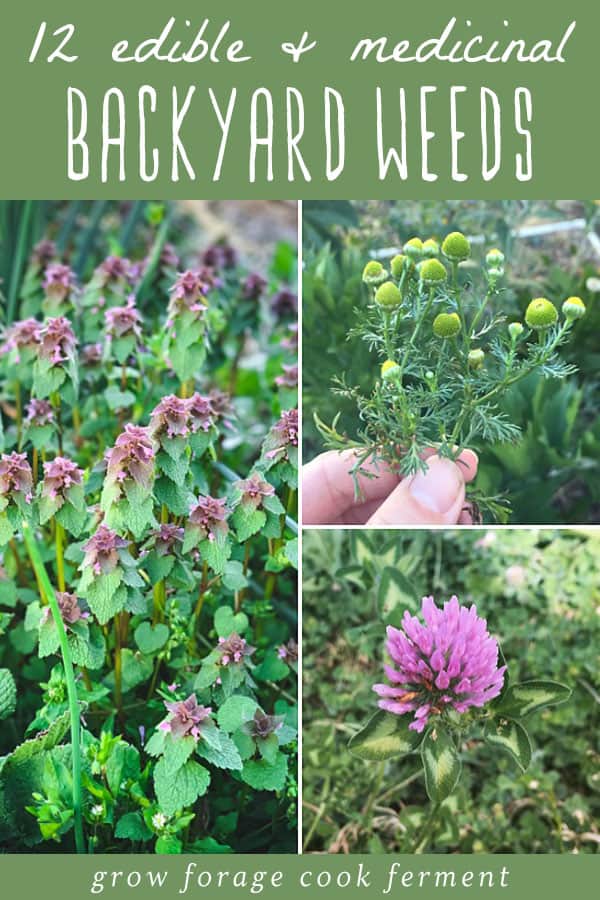
Want to save this post for later?
Wildcrafting Weeds
If you want to learn more about the edible and medicinal weeds that surround us and how to use them, check out my eBook: Wildcrafting Weeds: 20 Easy to Forage Edible and Medicinal Plants (that might be growing in your backyard)!
Edible Backyard Weeds
Weeds are all around us! Common weeds are often edible, and using them has potential benefits that most people may not know about.
Although long seen as a nuisance by gardeners wanting perfect lawns and landscapes, some edible weeds are amazingly useful for general wellness in various ways. They are persistent, resilient, and perhaps grow a little wild without looking perfectly contained.
But how wonderful to have plants that grow without maintenance and can be eaten so easily?
Plus, aren’t we all a bit wild, thorny, and not perfect at times? Weeds have so much value, and don’t deserve the bad reputation they have!
Related: What to Forage in Spring: 20 Edible and Medicinal Plants and Fungi, 13 Early Spring Edible Wild Greens
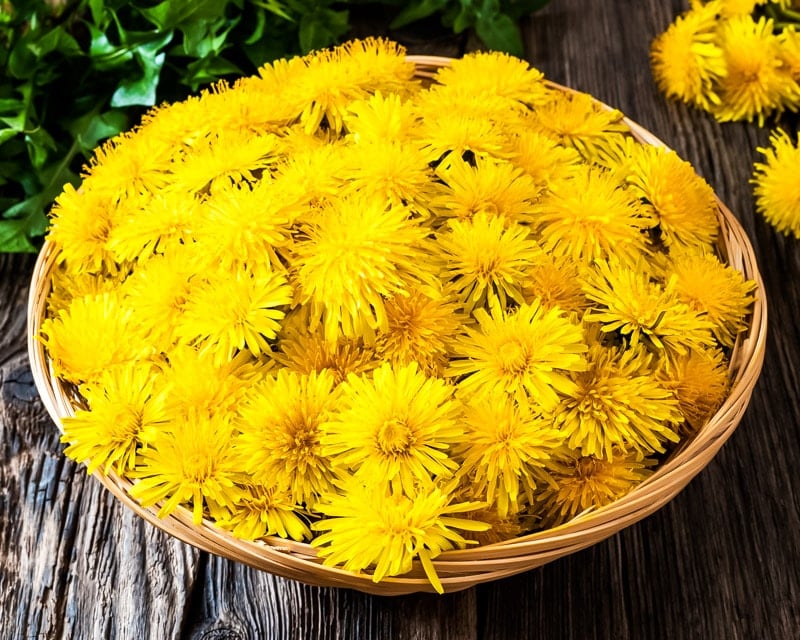
Dandelion
Dandelions are a perfect example of an edible weed that is super easy to find, identify, and use. They are useful in a wide variety of ways, and the whole plant, from flowers and leaves to roots, can be used!
Dandelions are also a perfect example of an edible weed that people often try to get rid of, even using harmful chemicals to do so.
However, people often don’t know how wellness-supporting l dandelions are. I say let them grow in your grass and wherever they may seed!
The closer they are to your door, the better! Step outside, and forage some dandelions for your health. Studies show that dandelions are rich in phenolic compounds, which can help reduce the risk of heart disease.
Dandelions benefit the body in many ways, including potential inflammation reduction, liver health, and digestion support. Many recipes use dandelions to their full potential, and they are also delicious!
There are only so many plants that can be used from flower to root (dandelion root that is), and dandelion is a champion, bold and humble!
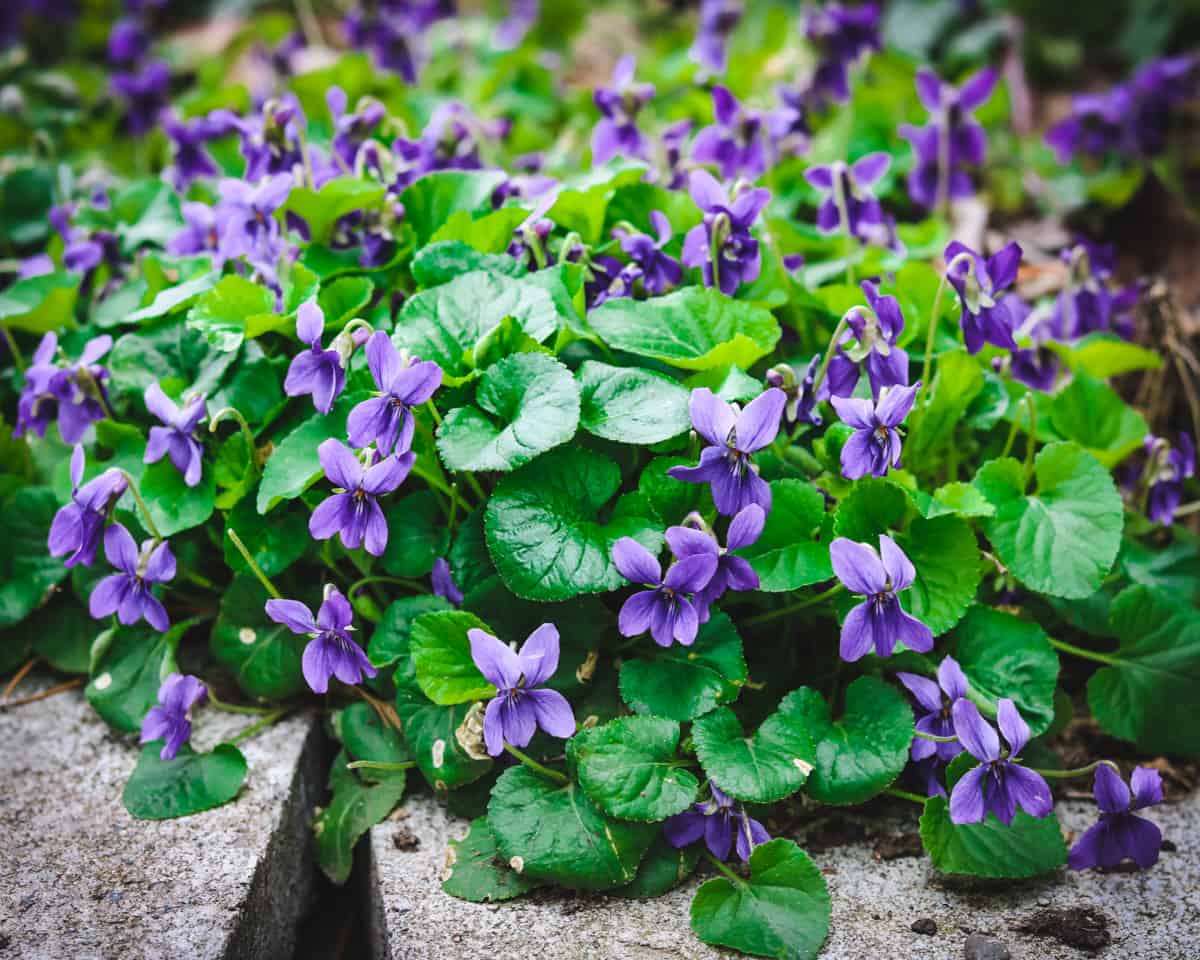
Wild Violet
Wild violets are edible; you have likely seen them in your backyard or nearby in the early weeks of spring. The flowers are dainty and will grow in wooded areas, in your side yard, or even in cracks of concrete.
Small but mighty, wild violets are easy to forage for. They don’t need anything from us and will grow in almost any circumstance. Yet they can support us at the same time. They are givers!
Once you identify and harvest some wild violets, you can use this delicious edible weed to make this wild violet flower infused vinegar. It is perfect for use in salads and drinks.
Another wonderful way to use wild violet flowers is to make this DIY wild violet soap. Studies show that violet flowers contain anti-inflammatory activity that can help soothe the skin. Making this soap is a fun way to celebrate spring’s return!
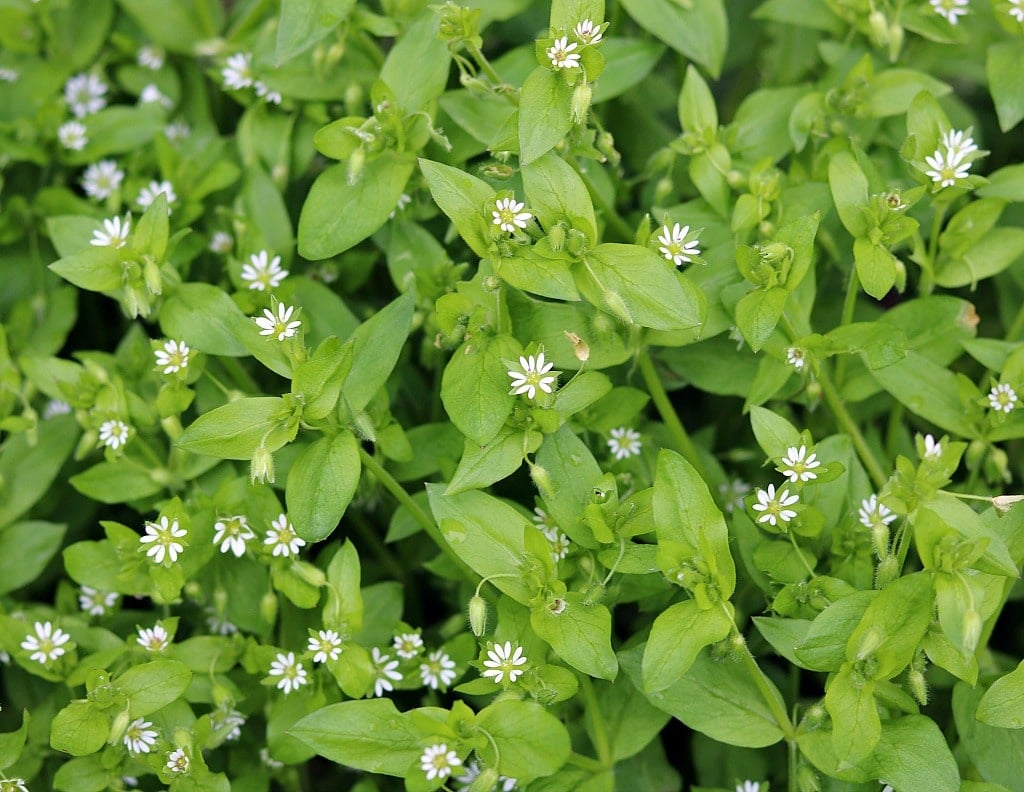
Chickweed
Chickweed has been studied and is a potentially extremely nutritious weed that is edible and grows readily almost everywhere, so you’re sure to have some growing nearby. Possibly even in your own yard!
Foraging chickweed tends to be easy since it is so common, simple to identify, and grows plentifully. Chickweed is edible and very useful, so it is definitely a plant you will want to keep around.
I didn’t notice chickweed until I really began looking for it, then I realized how abundantly it grows and saw it everywhere!
It’s small and unassuming, but it’s easy to use. Some studies show it may have anti-inflammatory and soothing effects when applied topically. Don’t pass it by, pull it up, or mow it over!
This chickweed pesto recipe is a super tasty way to use your foraged chickweed. It can also be made into a healing chickweed salve for the skin.
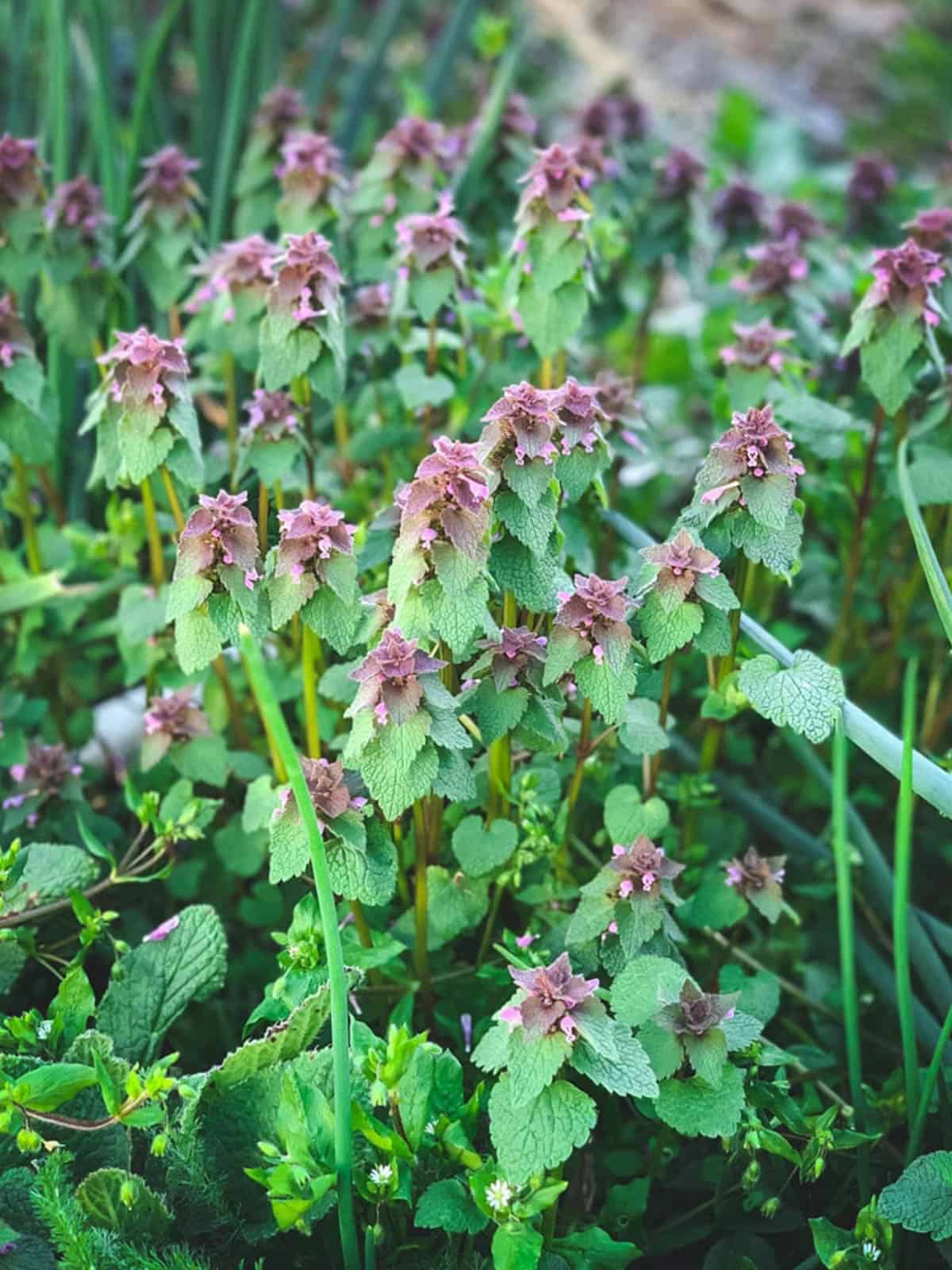
Purple Dead Nettle
Purple dead nettle is another plant you have likely seen often, even if you didn’t know what it was at the time. It grows readily in most places and is again seen as a weed, with most people not realizing how amazing they are.
It’s super easy to forage for purple dead nettle, since it’s likely in your yard or somewhere close! This is one edible weed you don’t want to pass up.
Purple dead nettle has a slight resemblance to stinging nettle, but without the sting, hence the name “dead nettle.”
The leaves are edible and can be used the same way you’d use any other leafy green. They are a bit fuzzy, so for salads, I recommend using them in a blend of other greens.
This wild-growing weed has been traditionally used in folk medicine as an astringent, anti-inflammatory, antibacterial, and more. This easy-to-find plant has a wide array of edible and herbal uses!
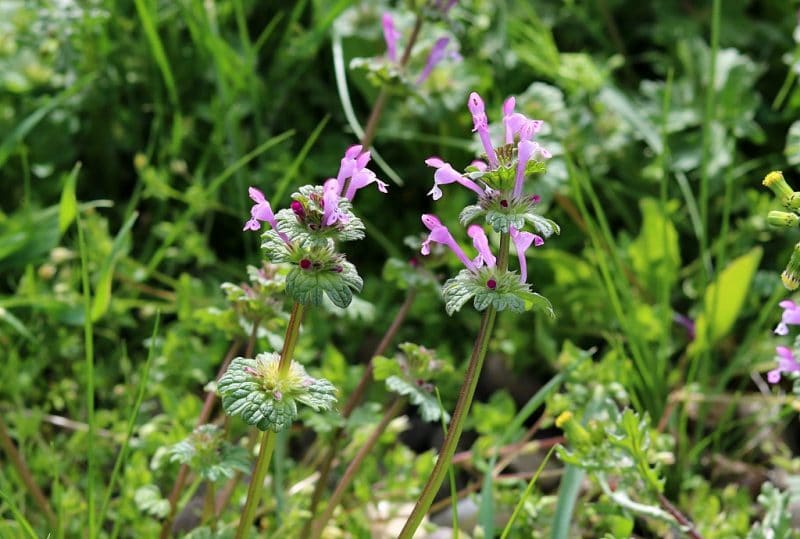
Henbit
Henbit is known for being a look-alike to purple dead nettle, and it is closely related. Growing worldwide, henbit is just as edible as purple dead nettle.
While you’ll often find them growing near each other, it is nothing to worry about if you get the two confused since they are both safe plants to use.
Henbit is an edible weed and a useful herb, used in folk medicine similarly to purple dead nettle. It makes a wonderful cup of tea after a spring foraging outing!
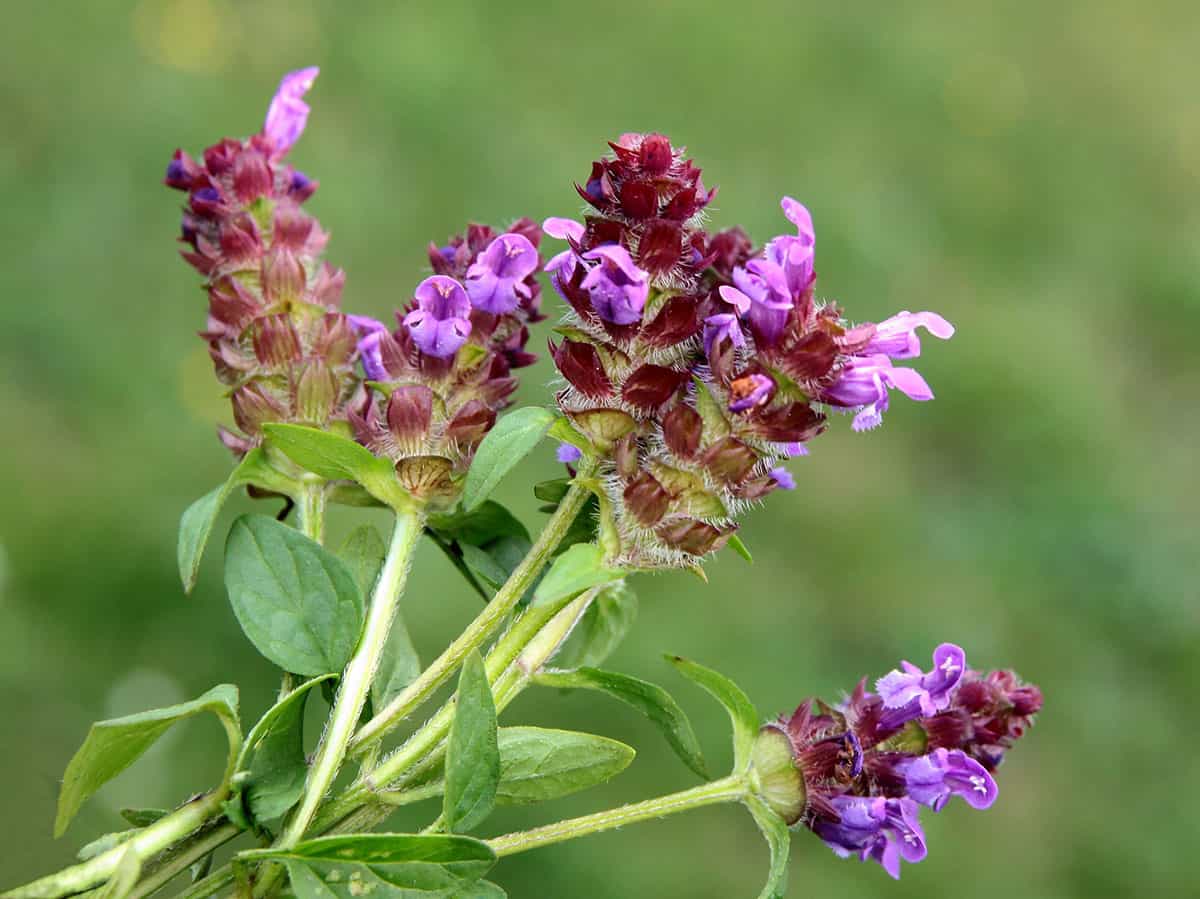
Self-Heal
Self-heal is a common herb in the mint family, but with no scent. It grows in temperate climates, and you’ll see it in wet soil areas along lakes and rivers, and on the edges of wooded areas. For many of us, that means in our yards too!
Self-heal is an edible weed. Its flowers are safe to eat raw, although they are a bit bitter. I like to add the leaves and flowers to smoothies or soups.
Modern pharmacological studies have shown that self-heal has extensive pharmacological activities. Although more research is needed, this herb has unique advantages in its ability to soothe and support a variety of health-related issues.
Self-heal makes a wonderful infused oil, salve, or tincture!
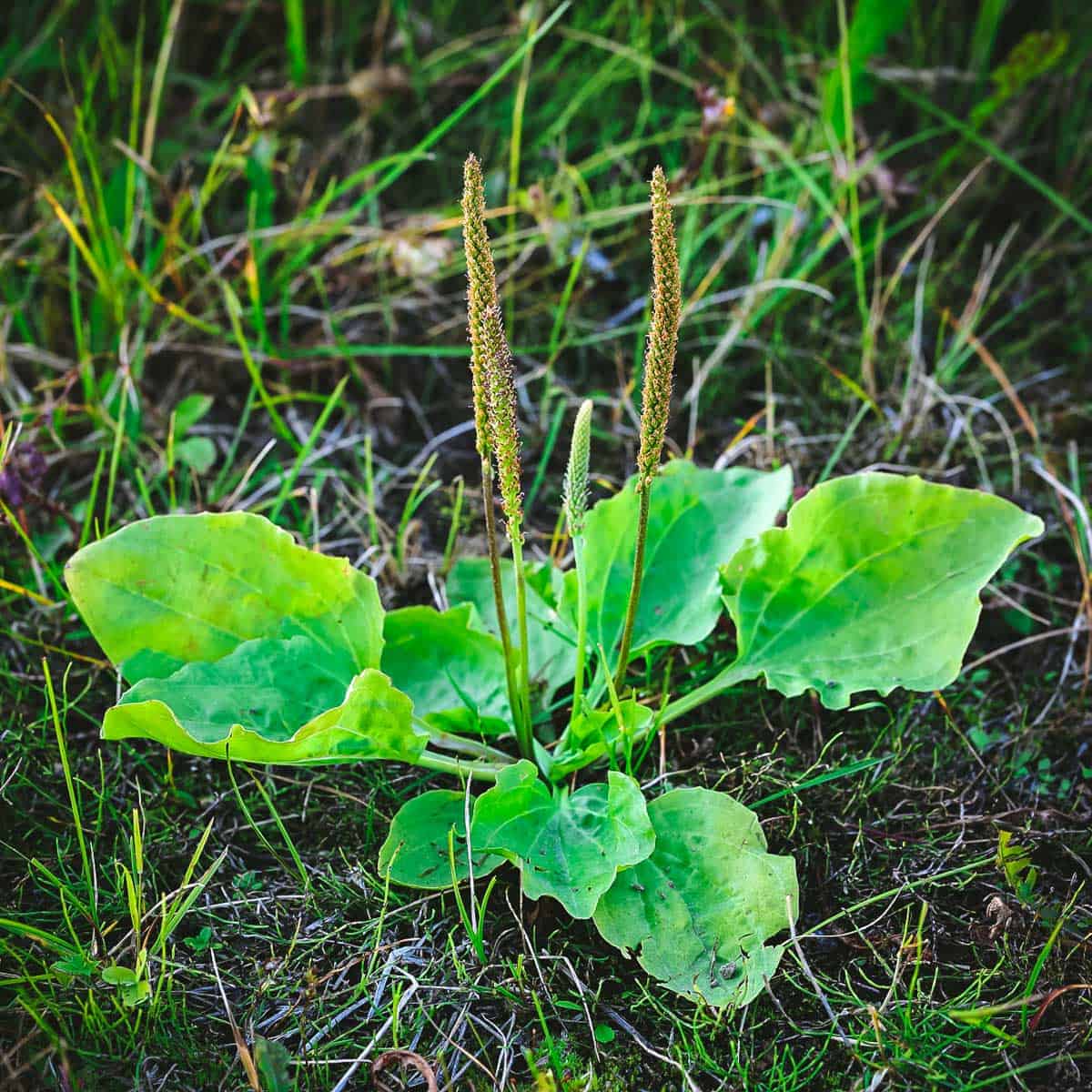
Plantain
Plantain is a common plant I saw all the time as a kid in my yard, around the fields, and towards the woods behind my house. I never knew how useful it was until recently!
You have likely seen plantain around, too. It’s so common you might not have noticed it! Foraging for plantain is incredibly easy.
Long known as “nature’s band-aid,” plantain ointment was shown in a study to be a safe and suitable herbal compound for treating second-degree burn wounds. It may promote wound healing, have analgesic and microbial properties. I always have plantain salve on hand!
Just when I thought I couldn’t love this common underdog “weed” more, I learned that plantain is also an edible weed! It is high in vitamins A, C, and K, and may be a source of iron, calcium, and magnesium.
You can add plantain leaves to soups and stews, or bake them and eat them like kale chips. Definitely don’t pass this amazing plant by, it grows world round, so you are sure to find some!
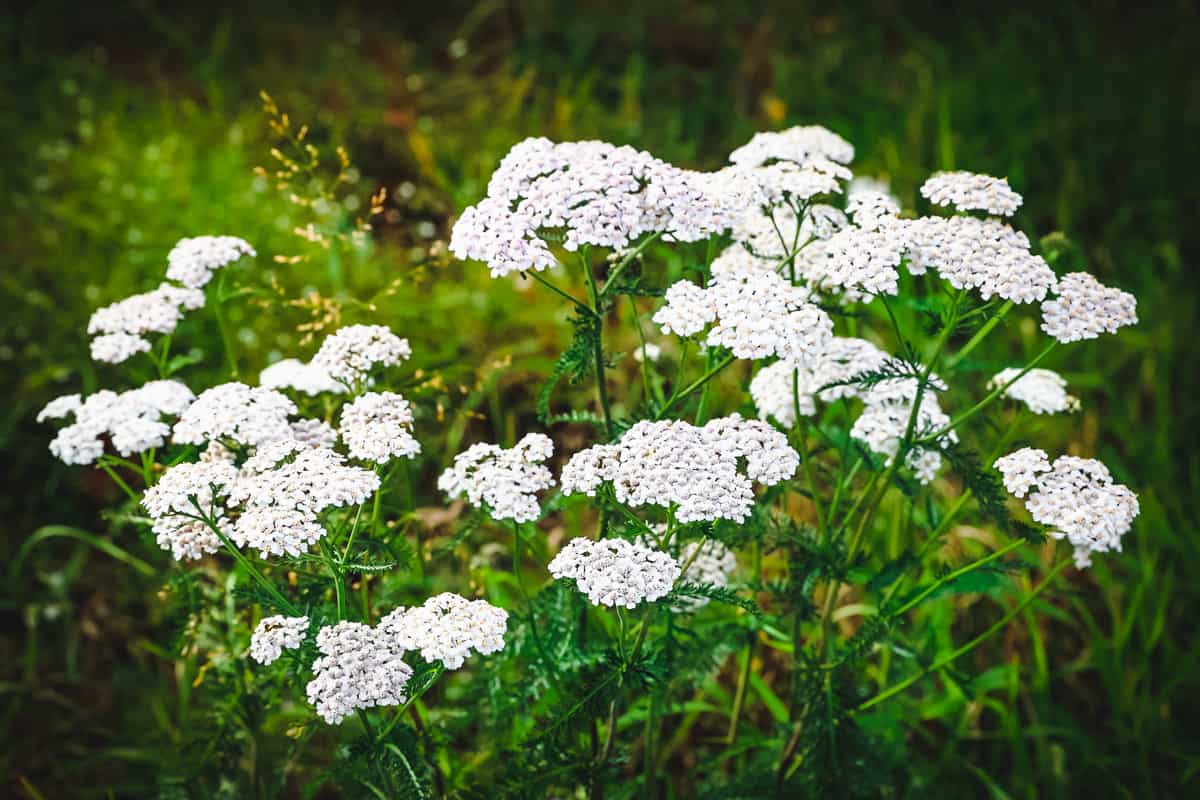
Yarrow
Yarrow grows nearly year-round in mild temperate climates, with small flowers blooming in spring and summer. The entire yarrow plant, from flowers, leaves, stems, and roots, can be useful for edible and herbal purposes.
You will find yarrow to forage in fields, yards, meadows, and disturbed areas. It is never far from where you may be out looking or wandering!
Yarrow has a few look-alikes to note, Queen Anne’s lace is one that is edible, and most notable is poison hemlock which is highly toxic. Be certain of your identification!
However, once you positively identify yarrow, you will be happy you did so, as it is a highly useful edible weed plant!
This wild rose and yarrow soap, yarrow salve and arnica and yarrow skin cream are great recipes to use your yarrow once you find, identify, and forage yarrow!
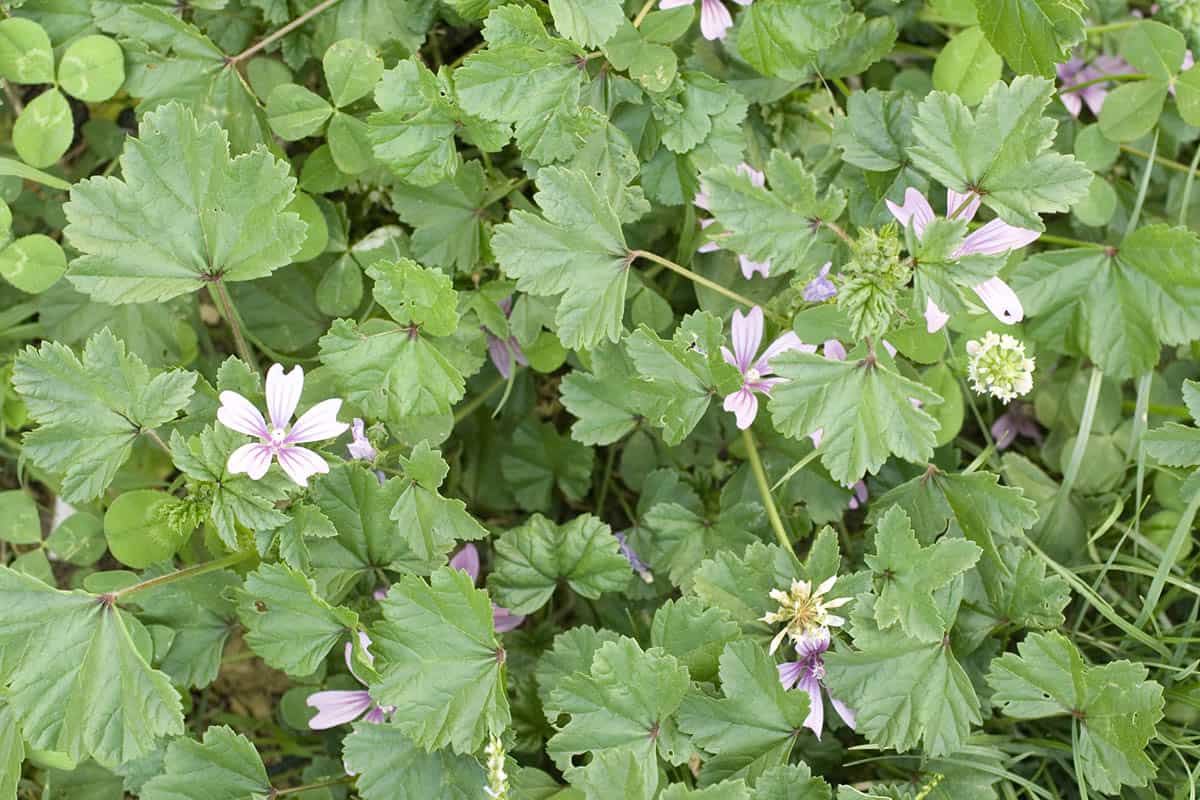
Mallow
Mallow grows in backyards worldwide, once you know what it looks like you will recognize it easily and often. It’s a low-growing annual plant with alternate roundish leaves that have tiny hairs.
Mallow has small pink or white flowers you’re sure to have seen in your own backyard, out of a crack in the sidewalk, or in between rocks.
Some species of mallow such as Malva sylvestris grow taller and have larger flowers.
The entire mallow plant is edible and makes a tasty and beautiful addition to salads. Cook the leaves and use them similarly to okra to thicken soups and stews. and they are rich in vitamins A and C, calcium, magnesium, potassium, iron, and selenium.
Studies have proven mallow’s potential for health benefits due to its antioxidant, anti-inflammatory, wound-healing, and antimicrobial activity. It may support the digestive system and ease sore throats and coughs.
Mallow leaves are hydrating and emollient, and they may help balance dry skin. Mallow makes a great cold water infusion, too!
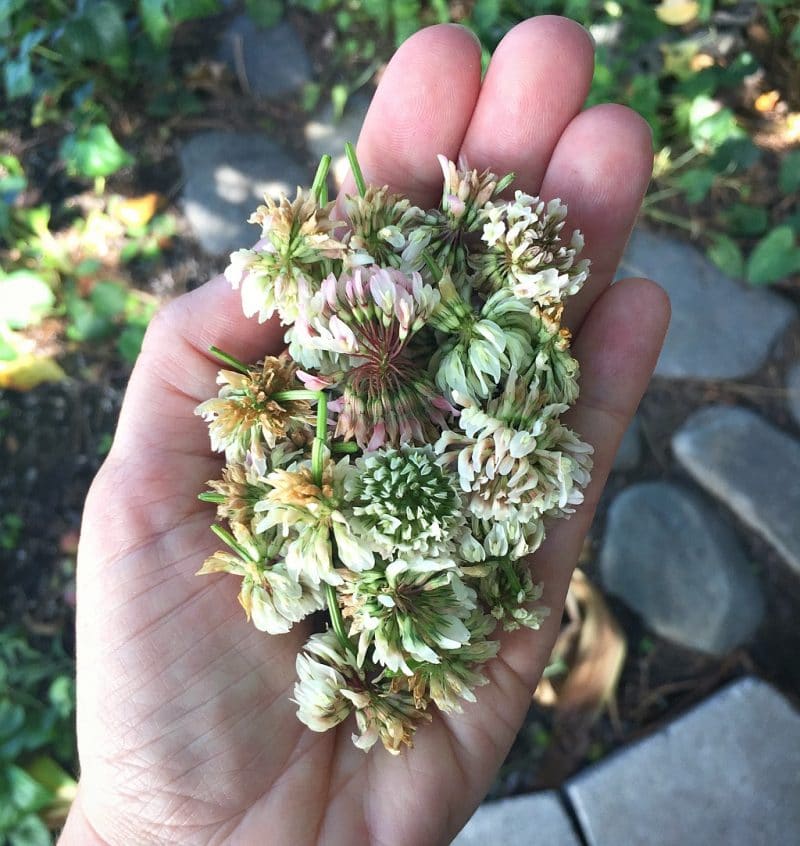
Clover
Clover is a low-growing perennial backyard plant that is drought resistant and grows in mat-like clusters. They have white or dark pink flowers, and you are sure to know them well as they especially like to grow in grassy areas.
I have lifelong memories of clover flowers in my grass! Little did I know that they are a tasty edible weed right in my yard.
Both red and white clover flowers might have soothing herbal uses.
You might not know that clover is in the legume family and is being studied as a promising protein source. The flowers have many vitamins and minerals and can be either eaten raw (hello, beautiful spring wild salad!) or made into this lovely white clover iced tea.
Red clover can be steeped into a tea to use as an overall wellness and soothing tonic. Although more research is needed, studies show that the anthocyanins of red clover can inhibit inflammation, which may be helpful for women’s menopausal hot flashes, fertility, and occasional swelling.
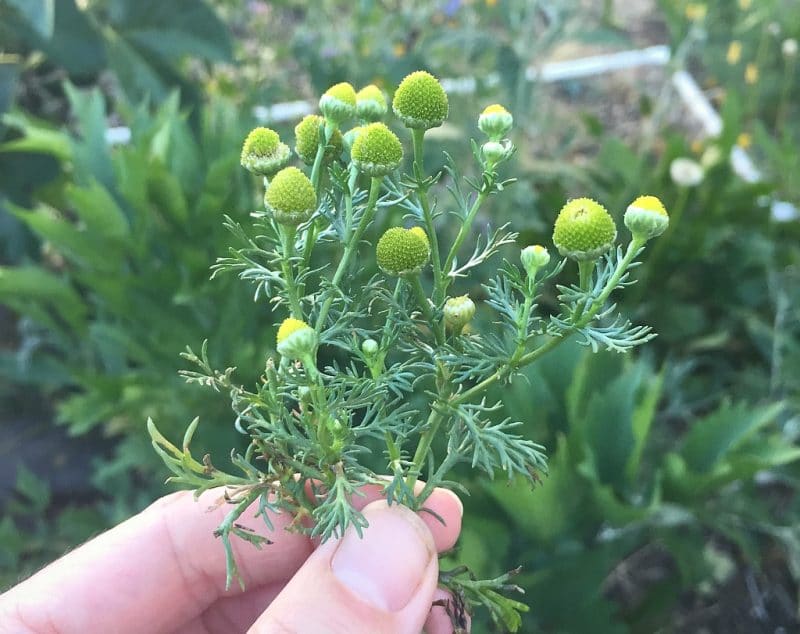
Pineapple Weed
Pineapple weed, also known as wild chamomile, is a plant I have seen around since my childhood without knowing what it was and how useful it is.
When I learned its uses are the same as chamomile, I was so excited! I love it when a plant that has always been there in its unassuming way, turns out to be a useful and edible weed!
Pineapple weed is easy to forage because it grows almost everywhere. It looks similar to cultivated chamomile, but without the white flower petals, and stays much closer to the ground.
It smells just like chamomile and is often found along walking paths, trails, and roadsides.
This sweet wild-growing plant has herbal and edible uses. Different therapeutic applications suggest chamomile as a promising herb (although clinical use has not been found).
Making pineapple weed tea is the most common way to ingest it, but there are other ways one can use this amazing plant!
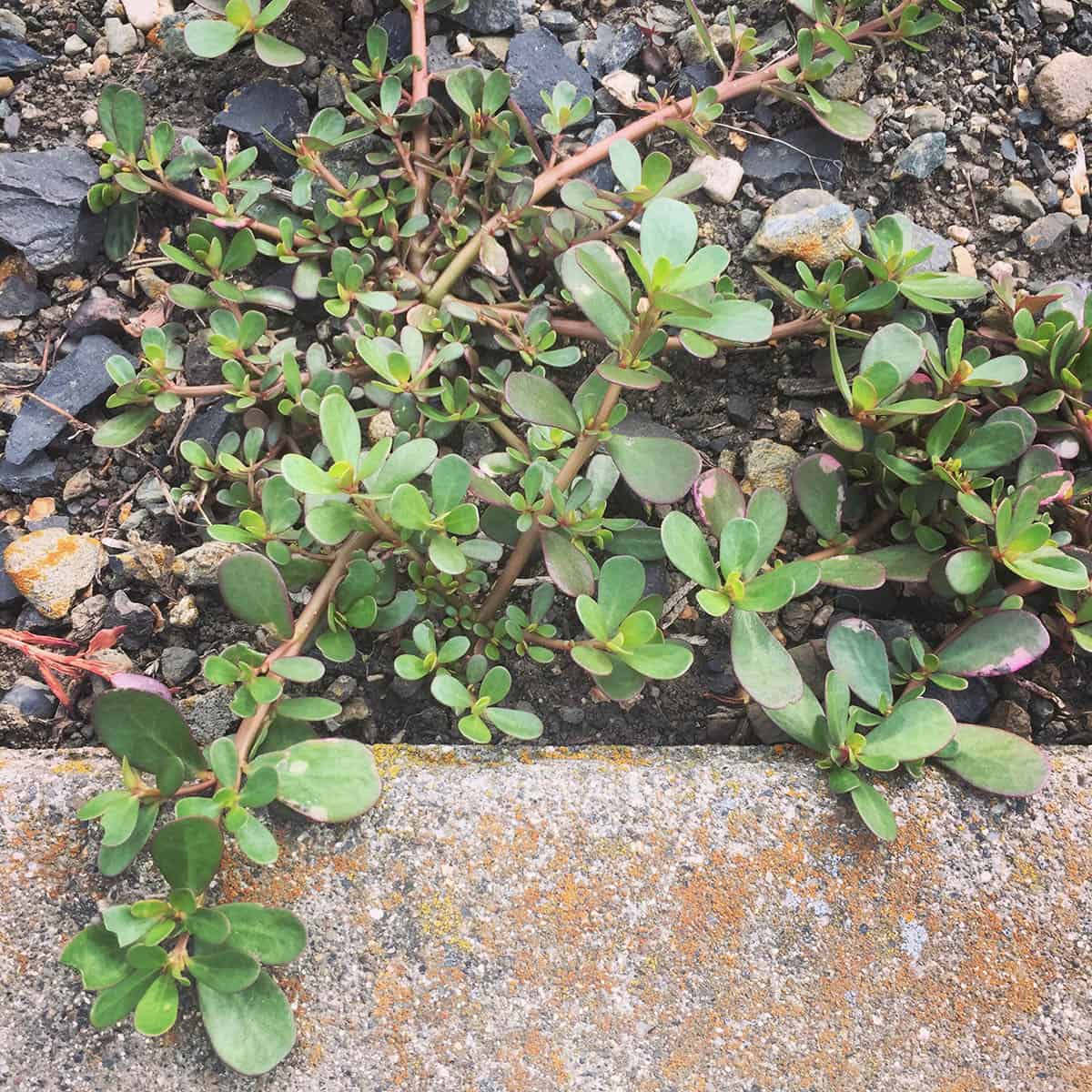
Purslane
Purslane is a very common garden “weed” you are sure to have seen before, even if you didn’t know how useful it is! It’s a trailing ground cover, and the leaves are succulent, fleshy, and paddle-shaped with a smooth surface and edges.
It has small yellow flowers that bloom mid-summer to early fall and has a distinctive thick and reddish stem. Be careful not to mix it up with hairy-stemmed spurge, which looks similar to purslane but is toxic.
Purslane grows wildly worldwide and can grow in conditions that many plants wouldn’t thrive in, with full sun and sandy soil. Purslane thrives in poor soil! You’ll find it growing in the cracks of sidewalks, in fields, and on lawns.
With both edible and herbal uses, purslane leaves can be eaten raw, cooked, or pickled. Purslane leaves are great for smoothies or thickening soups and stews.
Scientific analysis of the chemical components of purslane has shown that this common weed has uncommon nutritional value, making it a potentially essential food for the future with a high level of antioxidants.
The traditional use in the topical treatment of occasional swelling suggests that purslane is a highly likely candidate as a valuable soothing cosmetic ingredient.
Purslane is a strong, well-growing, super plant that thrives in the worst conditions, which personally inspires me!
Learn more about foraging purslane here.
Forage Edible Weeds in Your Backyard
Learn all there is to know about the plants that grow naturally all around us and close to home. They are strong, useful, and resilient.
Not only are they amazing and usable in a multitude of ways, but we humans can also learn from their persistence and humble strength!
Keep growing, thrive in the worst of conditions, restart on your own, and soothe everyone around you. These edible weeds are wise, beautiful, useful, and supportive. Use them to their potential!

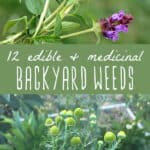

I was wondering if you could answer a question Im having a hard time finding the answer too? I’m currently renting and have been here for little over a year now. My family doesn’t use any chemicals to keep bugs away or weed killers but were not sure if the family before us did or not and the landlord doesn’t know either. Do you think if they did would a year be long enough for the plants to be safe to harvest for tincture, extracts, salves, and teas?
No, unfortunately not. I would wait a minimum of three years, just in case.
Such an informative article. I have most of these beneficial plants in my backyard and am so happy for that. Unfortunately, I do not have pineapple weed. I do know where some grows but it is in an area of high vehicle traffic. Can I take the plant heads and maybe use them as seeds to plant in my yard?
Unfortunately, pineapple weed does not like to be transplanted or grown from seed. You can definitely give it a try, but in my experience, it always dies.
I found some pepperwort in my yard and I’m wondering if you know anything about it’s benefits if it has any? I’m planning on dehydrating it and making tea from the roots leaves and leaves
Hi Megan. I’m unfamiliar with pepperwort. I suggest properly identifying it by its Latin name and searching for its medicinal uses that way.
excellent article! I find it so sad that the earth is always offering us these wonderful foods and medicines for free and yet humans with their mania for tidiness and control just ignore and poison them. “Perfect” grassy lawns seem very sterile and dull to me, when the alternative is a garden full of plants that can heal and feed humans and other animals alike.
I completely agree with you!
I believe that there are many different herbs growing all over the world that have properties in them which target certain ailments in the human body. I find it such a blessing and a comfort to know that we have “natural” remedies we can use. Even being able to use “weeds” is just amazing.
Thanks Colleen for your research and information. I have been using natural remedies on my children for years. Favourites being tea tree oil, lavender, camomile, clary sage and brahmi just lately.
You’re so welcome. Enjoy!
Thank you so much for this! I think everyone should have a medicinal garden in their backyard. I see no reason to take something made in lab, when you can first try a natural remedy you grow at home. You can easily go and pick the remedy you need at any time. Your backyard pharmacy will be there for you even in times of crisis when regular pharmacies might be closed or looted.
i enjoy looking these healing weed that pack with so much benefit
Thanks for this great reminder of what’s out there within reach. I, too, make a salve of plantain that heals the scratches from raspberry-picking. Great to see good photos of hen-bit and self-heal–the only 2 I’m not very familiar with.
Thank you for this post about foraging wild herbs. I already pick and use several of these. I also make a salve with plantain and it is excellent for burns as well as insect bites. I look forward to reading more.
That’s wonderful, Trish. Enjoy!